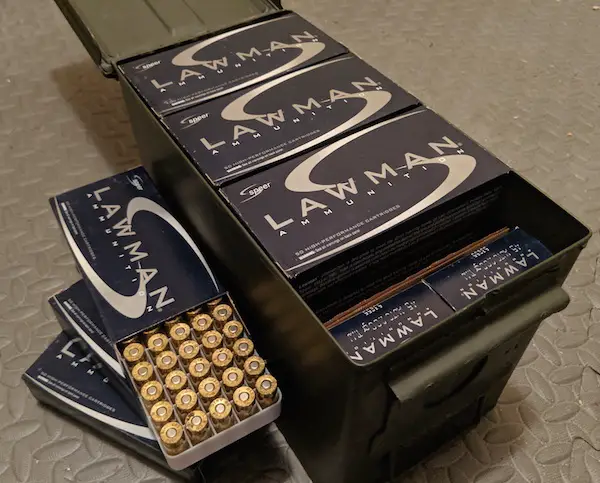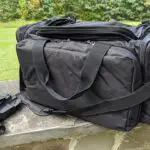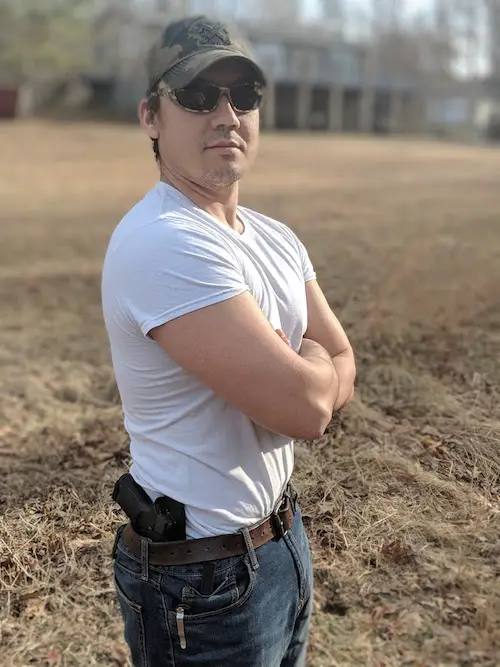Okay internet, today I’ll be talking all things ammo as it pertains to the gun range. After my gun range article I figured I should expound a bit on the quantity of ammunition you need in your range bag. The TLDR answer is this: You should have a minimum of 150 rounds of ammunition for each caliber round you intend to shoot. Multiply that number by the amount of hours you’ll be shooting to figure out how much ammo you should bring to the range.
Table of Contents
Factors That Impact How Much Ammo To Bring
The above explanation is an over simplified answer. In reality, how much ammo you pack for the range will vary depending on several factors. First, is whether you’ll be shooting alone or sharing the lane with another shooter. Second, your ammo needs will depend on the drills you’ll be performing. Third, the hardware you bring will dictate — to some degree — the amount of ammo you’ll need. Finally, the duration of your visit will impact the number of rounds you bring to the range.
Shooting With Others and Your Ammo Needs
Depending on who you will be sharing a lane with, your ammo needs may change drastically. Naturally, if you are the only person on the shooting lane you will likely go through less ammunition. At a minimum you’ll be able to monitor your rate of ammo usage. However, the proficiency of your shooting partner will also impact your ammo usage.
If you are sharing your lane with a beginner shooter, you could actually end up consuming less ammunition if they are timid about shooting. The noise may cause them to be hesitant to squeeze the trigger. This can lead to excessive time between shots.
Contrarily, if your shooting partner is trigger happy you will almost assuredly burn through your rounds than you would alone. It would be prudent to remind them that ammunition isn’t free. Additionally, focus on accuracy rather than quantity. A good technique to help conserve ammo is to provide them with only partially loaded magazines.
In my experience, veteran shooters are more apt to shoot ammo at a rate more consistent with your own. Generally, this is a result of an understanding of ammo costs and better understanding of effective use of rounds.Therefore, if your shooting partner is a veteran shooter you should be good with doubling the number of rounds you bring to the range.
How Shooting Drills Affect Your Ammo Supply
Whether you are shooting alone or with a partner, the type of shooting drills you will be doing will drastically affect your supply of ammunition. Drills that focus on accuracy of consecutive rounds will cause you to use more ammo quickly. If this is your primary focus plan on packing an additional 50-100 rounds per shooter. However, if you focus predominantly on peripheral shooting skills you’ll use less ammo.
If you’ll be firing multiple rounds without a significant rest period in between shots, then you’ll burn through ammo rather quickly. An example of this is the box drill which requires the shooter to engage multiple targets and fire consecutive rounds per target. Contrast that type of drill with any drill that focuses on secondary shooting skills, such as cycling an empty magazine, and you can see why your ammo consumption is going to be less.
Another consideration for ammo usage is the time spent reloading magazines. Sometimes drills can be performed with a full magazine. Other times, a partially loaded magazine is used to simulate different scenarios. If your drills require you to constantly break, and reload mags you will drastically decrease your ammunition usage.
How Many Magazines Do You Bring To The Range?
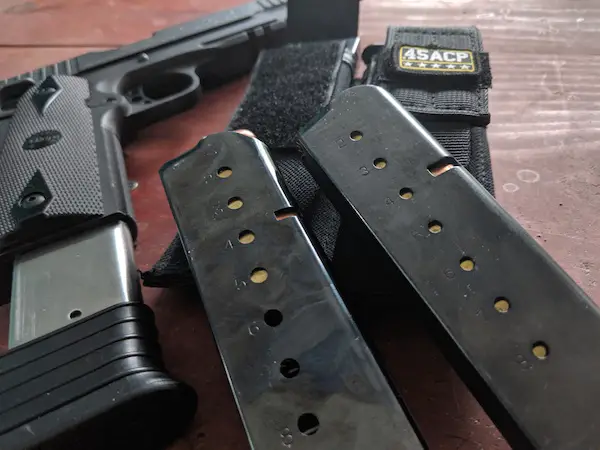
So I’ve spoken a bit about how reloading will affect the amount of ammunition you’ll need at the range. When I go to the range, I bring a minimum of two pistol magazines for each weapon I intend to shoot. However, I will Sometimes, I will bring a third magazine which I don’t use on the shooting lane but contains my daily carry ammo (i.e. hollow points) for after my range session.
If I have more magazines for a particular weapon, I will bring all that I own. The primary reason for this is because multiple magazines allow me to run through shooting drills without breaking for a reload. Additionally, extra magazines afford me the opportunity to practice cycling my pistol. A shooter can simulate common malfunctions that might require them to drop and replace their magazine.
I’ve found that reloading all your mags at one time is more efficient than doing one at a time. When the time comes I’ll grab my MagLula speed loader and load up all my mags at once. If you are not focused on skill development, having multiple magazines can actually increase your ammunition usage.
How Long Do You Spend At The Gun Range?
The last piece in determining how much ammo you need for the range is the duration of your visit. I personally spend between one and two hours at the gun range. If I’ve got a large group I’ll tend to shoot longer because I’ll be sharing the lane. Additionally, the more handguns I bring to shoot, or the group as a whole brings, the longer I spend on the shooting line.
A word to the wise, find out when there are lull’s at your local shooting range. Depending on the staff, you may be able to stretch out your lane time if there isn’t a line. It may only be 15 minutes, but you can get a decent amount of shooting done before the range master actually kicks you out. If you find your local range isn’t very strict about time limits during downtime, it is probably worth throwing an additional box of 50 rounds in your range bag on top of the recommended 150 rounds.
Transporting and Storing Range Ammo
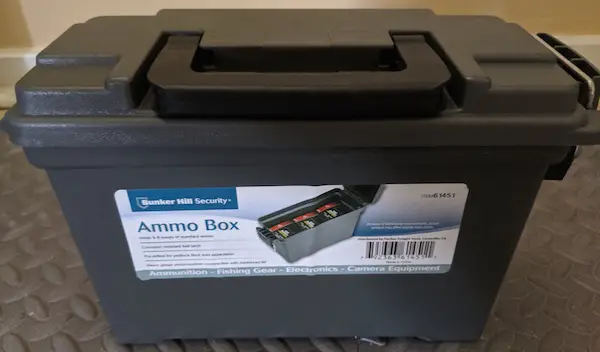
At this point we’ve covered how much ammunition you should be bringing with you to the range. Now, lets talk about transport and storage. If you have a range bag with adequate storage, you can simply but the boxes you bought from the store into the pockets. Otherwise, you can put loose rounds in an ammo box. Whichever method you use, throw in some desiccant packs to cut down on moisture.
I do not recommend that you keep loose rounds in a bag. Oftentimes you’ll find this type of ammunition at your local gun show. However, keeping this ammo dry can be troublesome. Additionally, you run the risk of the rounds spilling out all over the place. You’ll end up spending valuable range time picking up rounds off the ground or out of every crevice in your range bag.
What Kind Of Ammo To Use
Chances are your local shooting range has limitations on the ammo selection accepted for shooting. Additionally, many ranges reserve the right to inspect any ammunition brought to the range prior to letting you on the lanes. If you do not bring the correct ammunition you’ll be required to purchase ammunition on the spot if you want to shoot.
Another consideration for selecting your range ammo is matching, to the greatest extent possible, the ammo you regularly carry. You won’t be able to shoot hollow point ammunition at most indoor ranges. However you can match casing material and grain count of your practice ammunition to your carry ammunition. This will most accurately reproduce the conditions you’ll experience should you ever have to fire your weapon in self defense.
Steel Case Vs. Brass Case Ammo
It can be tempting to grab the cheapest box of ammunition from your local vendor. However, your best bet for ensuring your ammunition complies with range requirements is to buy brass case ammunition. Generally, this ammunition is slightly more expensive than its steel case counterpart.
I prefer brass case over steel, or any other casing material for that matter. However, I have accidentally picket up steel case ammo on occasion and it has shot fine for me. Although, I have heard of other shooters experiences many problems (e.g. failure to feed, failure to eject, etc.) with casings made of anything but brass.
Hollow, No No
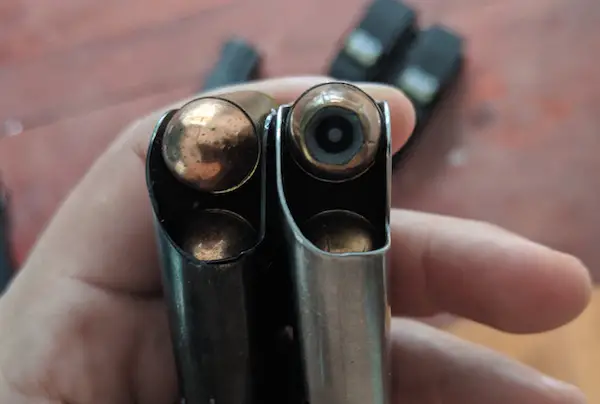
Some types of ammo, excluding ball ammunition, can wreak havoc on bullet traps. So to prevent premature wear on their bullet traps and prevent potential fragmenting or ricochets, some ranges will forbid the use of hollow point ammunition. I personally always use ball ammunition on the range, regardless of whether the backstop is a bullet trap or berm. However, it is at the discretion of the range to decide what type of ammunition is permitted. Remember, they will generally inspect any ammo brought to the range and not purchased on the spot.
Bring It, Don’t Buy It
One last tidbit of advice for your ammo selection at the range, bring your own ammunition whenever possible. Shooting ranges are a business and are in it to make money, so ammo is generally marked up from other vendors. You’ll need to make sure that you can bring your own and follow the above guidelines when selecting the ammo you’ll shoot on the range.
Parting Shots
Hopefully you have a better understanding of how much ammo you need to bring with you to the range, and what factors can impact your ammunition consumption. Do you have anything to add? Perhaps you bring more ammo to the range and have a different reasoning. Please share your thoughts in the comment section below.
